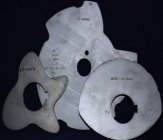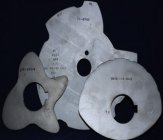are those the feed gears or the spindle gears?I can still see the wall of cams in my sleep
You are using an out of date browser. It may not display this or other websites correctly.
You should upgrade or use an alternative browser.
You should upgrade or use an alternative browser.
Another auto retracting tool holder
- Thread starter BoydAllen
- Start date
Dusty Stevens
Shiner
Dusty Stevens
Shiner
On a Acme, the feed for each position was at the same rate. So, the feed rate (how many thou per rev) was calculated on the tool that required the the least amount of feed. The feed gears used determined the rate. Cams advanced and retracted the tools. Cams determine how far the tool would advance when in 'feed' direction (1/8", 3/16, 1/4, ect), and retracted the slides so the carriage could index. The spindles (4, 6, or 8 of them) all turned at the same RPM all the time. There are 'auxiliary' positions for the 1st, 2nd ,3rd and 4th positions on the end slide for high speed drilling, and reducing the feed rate for threading. and for increased feed rate for reaming. All in all, 'screw' machines of any make or model were (pre CNC) mechanical wonders. 25,000+ orders of the 'part' were the norm. All run on 1 high hp. , 3 phase motor. I was surprised to find video on YT, most times at not so good resolution, though.
Dusty Stevens
Shiner
Yea these all had the loudest 7.5hp motor you could find. There are quite a few davenport videos on youtube. In most you can tell why im half deaf even wearing shooting muffs anytime a spindle turned. Most operators ran 5-6 machines at a time according to the complexity of the parts so you can see how a guy can wear out calipers and mics in short order. The days went by very fast though. You had to check 5 parts in a row then accept that batch and go to the next machine all while loading bars and keeping everything sharp and tweaked.On a Acme, the feed for each position was at the same rate. So, the feed rate (how many thou per rev) was calculated on the tool that required the the least amount of feed. The feed gears used determined the rate. Cams advanced and retracted the tools. Cams determine how far the tool would advance when in 'feed' direction (1/8", 3/16, 1/4, ect), and retracted the slides so the carriage could index. The spindles (4, 6, or 8 of them) all turned at the same RPM all the time. There are 'auxiliary' positions for the 1st, 2nd ,3rd and 4th positions on the end slide for high speed drilling, and reducing the feed rate for threading. and for increased feed rate for reaming. All in all, 'screw' machines of any make or model were (pre CNC) mechanical wonders. 25,000+ orders of the 'part' were the norm. All run on 1 high hp. , 3 phase motor. I was surprised to find video on YT, most times at not so good resolution, though.
Gun Smith
Gold $$ Contributor
I've worked in many factories and machine shops years ago. One place had at least 20, 6 spindle screw machines, and numerous other screw machines. Most of them were Acme-Gridley if I recall, and some of them still had Lend Lease badges from WWII Britain, that came back here after the war. That place made mainly brass automotive fittings if I recall. The noise was unbearable with the spindles going non-stop, yet most of the machine operators wore no ear protection, as they most likely were already deaf! It was cool to watch those machines spit out parts.We used self-opening die heads on screw machines and turret lathes. Want to see 'genius'? You should watch a multiple spindle automatic bar machine run for awhile.
I worked 4 and 6 spindle machines. 9/16" and 1 1/4" six spindle and 1" four spindle. Each set-up/operator had 2 machines to care for. Sometimes we had a laborer to help load bars and take care of chips, and sometimes not. The 6 spindle 1 1/4" machines had 30hp and the 9/16" and 1" had 25hp. I got pulled off the line at times, to set-up secondary manual mills/lathes/gang drill presses. Everything was HS then. I can't imagine what a Acme tooled with carbide would be like! A well taken care of Acme-Gridley with a war production tag could still be making good parts today. Made in Cleveland, seasoned castings, and the mechanicals all harder than the hubs. And, plenty of oil for lube......Yea these all had the loudest 7.5hp motor you could find. There are quite a few davenport videos on youtube. In most you can tell why im half deaf even wearing shooting muffs anytime a spindle turned. Most operators ran 5-6 machines at a time according to the complexity of the parts so you can see how a guy can wear out calipers and mics in short order. The days went by very fast though. You had to check 5 parts in a row then accept that batch and go to the next machine all while loading bars and keeping everything sharp and tweaked.
Last edited:
My first job was at a company called Parker Hannifin. They had 50 Acme Gridleys, the largest could handle up to 3 inch hex bars. They also had a couple of those Davenport machines. We made all sorts of hose fittings. Yes they were Noisy. One of the jobs I had was running a bar marking machine and ran every hex bar thru it to number and put a PH stamp on the opposite side. That was back in 1972, brought up a lot of memories.
Tarey
Tarey
Similar threads
- Replies
- 71
- Views
- 3,708
Upgrades & Donations
This Forum's expenses are primarily paid by member contributions. You can upgrade your Forum membership in seconds. Gold and Silver members get unlimited FREE classifieds for one year. Gold members can upload custom avatars.

Click Upgrade Membership Button ABOVE to get Gold or Silver Status.
You can also donate any amount, large or small, with the button below. Include your Forum Name in the PayPal Notes field.
To DONATE by CHECK, or make a recurring donation, CLICK HERE to learn how.

Click Upgrade Membership Button ABOVE to get Gold or Silver Status.
You can also donate any amount, large or small, with the button below. Include your Forum Name in the PayPal Notes field.
To DONATE by CHECK, or make a recurring donation, CLICK HERE to learn how.











